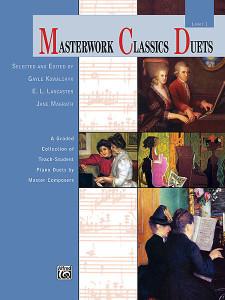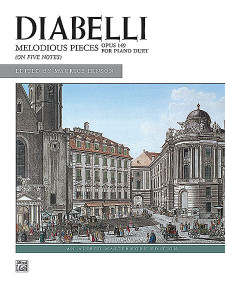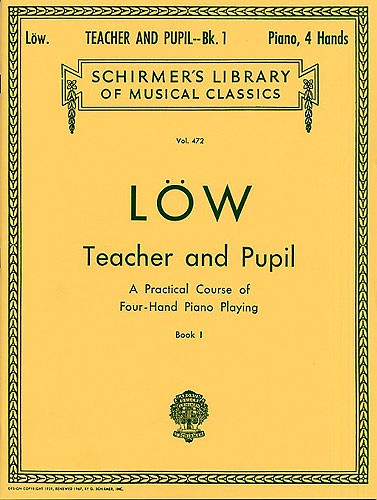Yesterday’s blog post described the benefits of using duets in the lesson for improving sight-reading. Today, I have a few recommendations for books that work well for this purpose.
“Improve Your Sight-Reading! Duets” by Paul Harris
 These books are gold, I tell you! I found these books when they were featured on the “New Items” rack at my local music store a few months ago. I purchased the Grades 0-1 book (Beginner to Early Elementary) and the Grades 2-3 book (Elementary to Late Elementary). I hope additional levels will be released soon! This series is published by Faber Music (not to be confused with Nancy & Randy Faber’s materials).
These books are gold, I tell you! I found these books when they were featured on the “New Items” rack at my local music store a few months ago. I purchased the Grades 0-1 book (Beginner to Early Elementary) and the Grades 2-3 book (Elementary to Late Elementary). I hope additional levels will be released soon! This series is published by Faber Music (not to be confused with Nancy & Randy Faber’s materials).
Take a look at some sample pages below. One page is marked as the teacher’s page and the other page is marked as the pupil’s page. The sight-reading examples are short and sweet.  Can you read the titles of the examples? This page features “Cup of Tea,” “By the Lake on a Warm Summer’s Day,” and “March of the Piano Teachers.” My students and I giggled about the last one. 🙂 My students adore this book because of the descriptive titles and the variety of styles/moods.
Can you read the titles of the examples? This page features “Cup of Tea,” “By the Lake on a Warm Summer’s Day,” and “March of the Piano Teachers.” My students and I giggled about the last one. 🙂 My students adore this book because of the descriptive titles and the variety of styles/moods.
The Table of Contents at the front of the book provides a helpful outline of the concepts required for each page of duets. The only downside to these books is that the first book advances very rapidly.
In my studio copies, I use Post-It notes with the students’ name as bookmarks to track of how far we are through the book. Students can also purchase their own copies of the books to practice throughout the week and then be rewarded by playing the duets together at the lesson.
Primo Light and Secondo Light (Kjos Publishing)
These two books are edited by the duo team Nancy Arganbright and Dallas Weekley. In Primo Light, the Primo parts are chosen for their simple, five-finger melodies, while in Secondo Light, the Secondo parts are the five-finger melodies.
Masterwork Classics Duets (Alfred Publishing)
 I love the Masterwork Classics books, so I was thrilled to hear about the release of these new, corresponding duet books.
I love the Masterwork Classics books, so I was thrilled to hear about the release of these new, corresponding duet books.
Like the previously-mentioned books, these are intended to be teacher-student duets (according to the cover). Although they weren’t likely intended for sight-reading situations, they work very well. These are wonderful books for the teacher’s bookshelf as well as for students to purchase and treasure for years to come.
Each book contains a nice variety of classical duets by composers who lived in the 18th, 19th, and 20th centuries. These books are appropriate for students of all ages (even adult students).
In Level 1 and Level 2, the duets are mostly 1-page in length with the student part limited to 5-finger positions.
So far, Levels 1-6 are currently available. There is also a value pack available for Levels 1 and 2 and Levels 3 and 4.
Diabelli’s Melodious Exercises, Op. 149
 Diabelli’s Op. 149 is a pedagogical work intended for teachers and students. The Primo part for each duet is limited to 5-finger positions. The 28 duets are organized by key (C, G, F, D, A, and E major/minor). Beginner students will no doubt be proud to hear how they sound when the teacher plays these accompaniment parts!
Diabelli’s Op. 149 is a pedagogical work intended for teachers and students. The Primo part for each duet is limited to 5-finger positions. The 28 duets are organized by key (C, G, F, D, A, and E major/minor). Beginner students will no doubt be proud to hear how they sound when the teacher plays these accompaniment parts!
Click here to read a great blog post on the New School for Music Study’s blog about using the Diabelli Op. 149 duets.
Diabelli’s Op. 149 is in the public domain and can be downloaded from imslp.org. For my studio copy, I bought the Peters Edition (which looks much like the version at imslp.org), but I would recommend getting the Alfred edition in hope that the score would be bigger/clearer. The Alfred edition also omits some of the excessive fingering markings. I am not sure what the score looks like inside this Schott edition, but it comes with a CD containing recordings of the Secondo parts for students to play along with.
 Joseph Löw’s Teacher and Pupil
Joseph Löw’s Teacher and Pupil
The duets in this collection are, as the title implies, intended for teachers and their students to play. The student plays the Primo part and the teacher plays the Secondo. There is a good variety of major and minor keys used throughout the collection. Near the beginning of the collection, the Primo parts stay within five-finger positions. Gradually, the Primo parts require the student to move around outside of a five-finger position.
The Kalmus edition reportedly contains typos and mistakes. The Schirmer edition, if you can find it, is more accurate although the typography is not as nice. Schirmer publishes the collection in two volumes. Here is Book I on Amazon.
Albert Loeschhorn’s 10 Children’s Pieces for 4 Hands, Op. 182
These 10 pieces feature simple but tuneful 5-finger melodies in the Primo part with more complex accompaniments in the Secondo part. If you can’t find this collection in print, you can download a public domain PDF score here at imslp.org.
Moritz Moszkowski’s Op. 96 Teacher and Pupil
This set of 8 pieces is wonderful because the student’s 5-finger part is in the Secondo part, which means the student is exposed to plenty of bass clef reading. The Primo part is much more advanced, as appropriate for the teacher to play. Find the public domain PDF score here.
Samuel Maykapar’s First Steps, Op. 29 for Piano Duet
This book, published by Minus Music One, features Op. 29 by Samuel Maykapar. The Primo Part is comprised of simple 5-finger melodies while the Secondo part is comprised of full accompaniments. Check out a preview of the book here.
Ettore Pozzoli’s Smiles of Childhood
Smiles of Childhood (originally “Sorrisi infantili”) is a set of 20 five-finger compositions for students with teacher accompaniments. The melodies are lively and interesting due to the use of various articulations and rests.
Wrapping Up
Those are just a few books that have been recently added to my shelf of piano ensemble books. Please leave a comment below if you have a recommendation for a duet book that would word well for teacher-student duet sight-reading! (And if anyone has found a good edition with a clear score of the Diabelli Op. 149 duets, please let me know!)



So excited about the Paul Harris book Joy! Didn’t know about those. Thanks so much for sharing.
I have also found the “Pentascale Pro” books by Bober, Kowalchyk & Lancaster wonderful for this same purpose. The harmony of the teacher duet part is so interesting and surprising. They are a real joy to hear and play together. I think they only have two books out so far: Elementary & Late Elementary.
Thanks for the recommendation, Becky! I will check those books out!
Wonderful recommendations. Thank you!